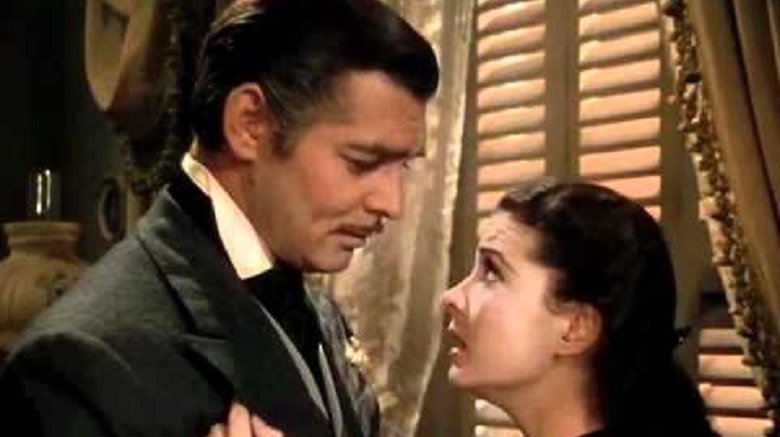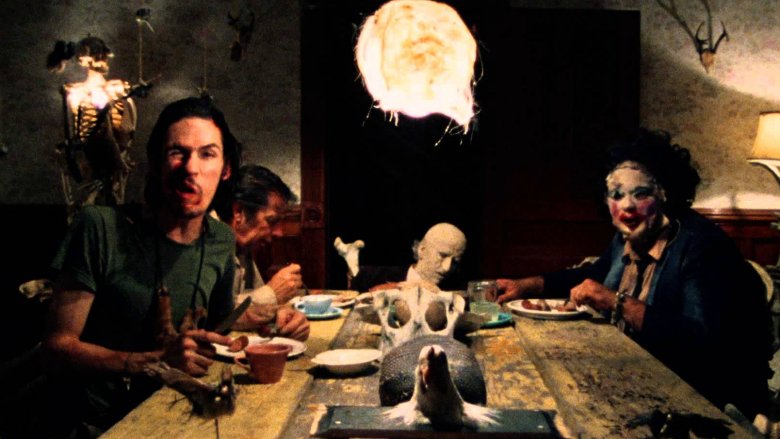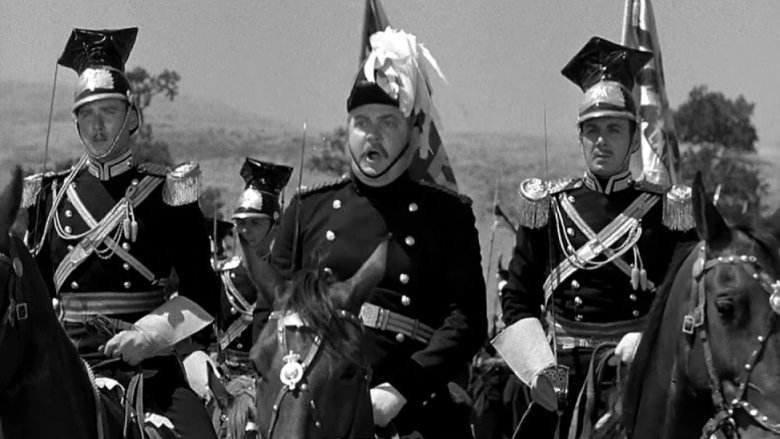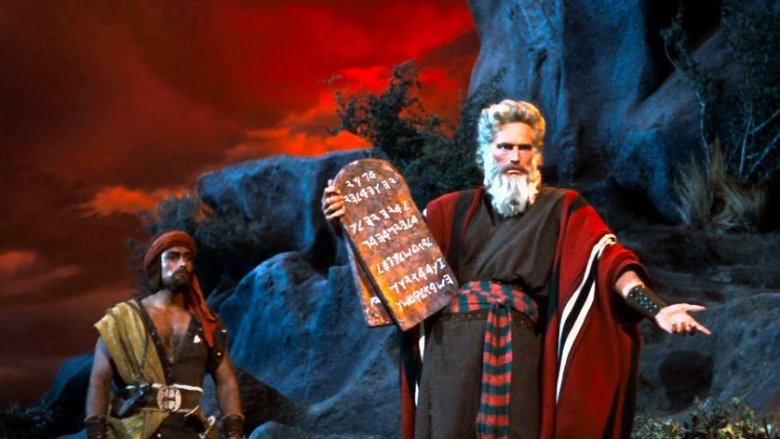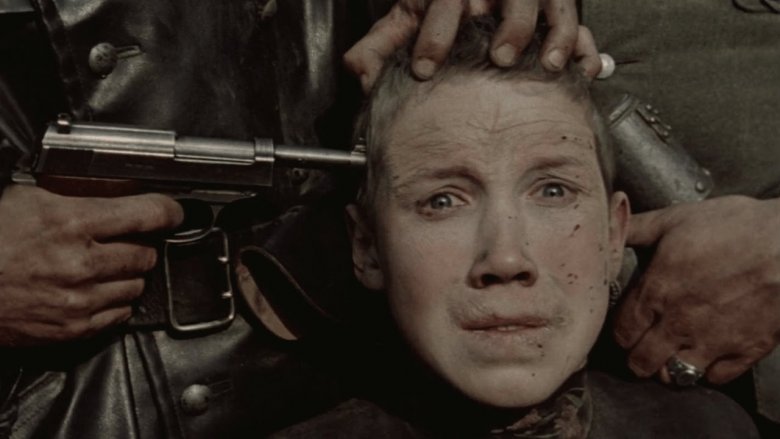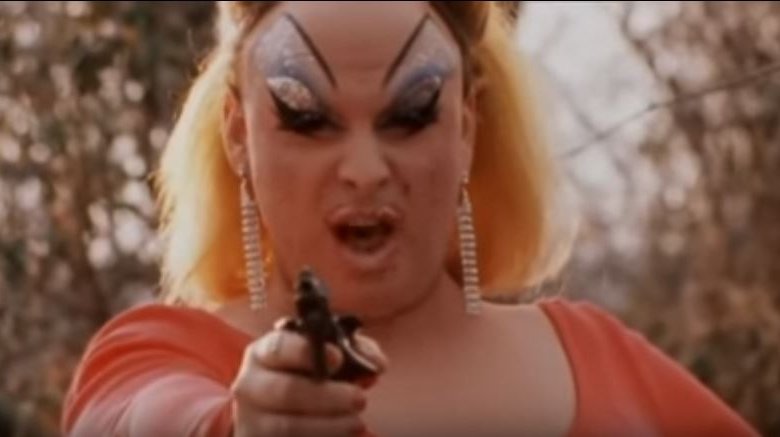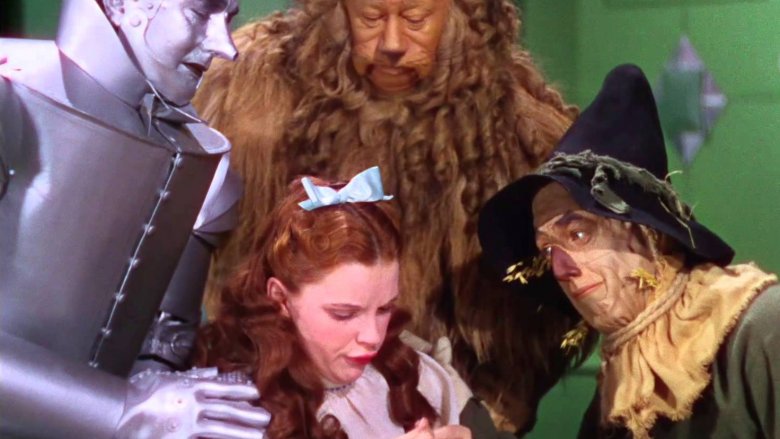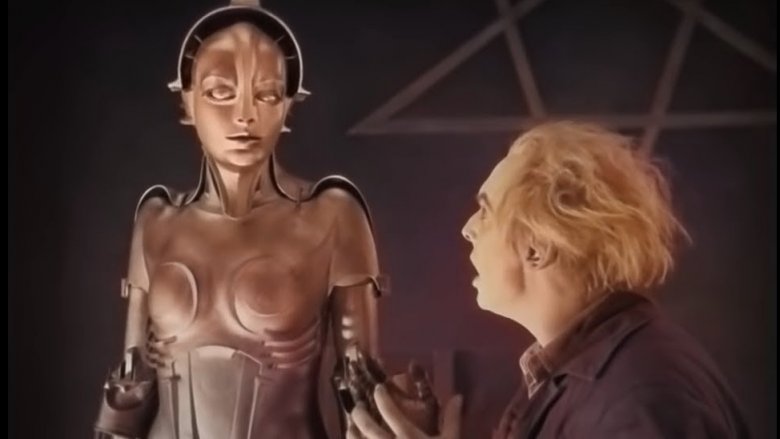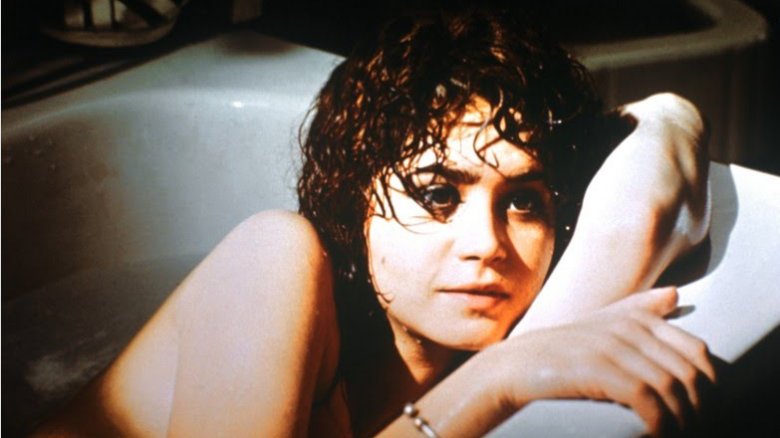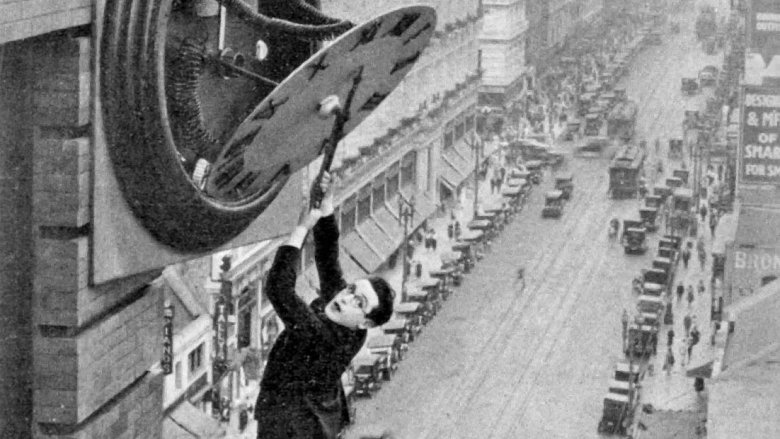Things That Happened On Classic Film Sets That Would Be Way Illegal Today
Despite its decadent image, a modern Hollywood movie set is probably one of the safest places you can be. Working hours are strictly controlled, people are (it seems) on high alert for creepy predators and bad behavior, bullying by directors can result in lawsuits, and even insects have their own special handler to make sure no one squishes them. (Seriously: Steven Kutcher.) It all sounds so overpoliced and sterile that it can leave you pining for classic film sets where directors like John Ford were such hardasses they could make manly men like John Wayne break down and cry.
Well, there's a reason Hollywood sets are no longer like this, and that's because producers and directors used to take such extreme liberties that they routinely endangered not just the lives of their stunt guys and animals, but their stars, lighting technicians, and coffee boys to boot. With all the stuff they were getting up to on classic film sets, it's a wonder everyone didn't wind up in jail.
Every Golden Age MGM movie had scheduled brothel visits
The words "Golden Age MGM movies" can be a little abstract. So here's a list of some you may recognize. Gone With the Wind. The Wizard of Oz. Mutiny on the Bounty. The Philadelphia Story. Okay, everyone know at least a couple of those? Well, prepare to have your memories soiled. Every single one of those movies took place at a time when MGM forced its male stars to partake in scheduled brothel visits.
Marc Eliot's influential biography of Jimmy Stewart has a detailed account of the system, and it's as nauseating as it is fascinating. Built by Judy Garland's personal Big Bad, Louis B. Mayer, the MGM brothel was a short walk from the front gate, and compulsory for all male contract stars. Like many men in the 1930s, Mayer was a raging homophobe, and forcing his actors to sleep with ladies of the night was supposedly his way of separating the manly heterosexuals from the manly homosexuals. It also had the bonus of meaning none of those manly hetrosexuals had time to sleep with the actresses Mayer wanted to prey on (via The Telegraph).
Everyone from Jimmy Stewart to Spencer Tracy to Clark Gable was forced to trot down to the brothel like it was the studio gym. Refusing to go was grounds for dismissal. So remember, next time you're watching Gone With the Wind, Rhett Butler was spending his time between takes at a subsidized brothel and probably hating every minute of it.
Texas Chain Saw Massacre's cast operated real chainsaws while high
Tobe Hooper's 1974 horror classic Texas Chain Saw Massacre got its reputation in part because it really felt like the movie was made by a bunch of drug-crazed hillbillies. Judging by the on-set antics, that ain't too far from the truth. Most fans have heard the tale of Marilyn Burns' finger getting sliced open for real in the dinner scene. Such a relatively minor injury could have been the least of the producers' worries. On the final night of filming, Leatherface actor Gunnar Hansen had to do a stunt with a chainsaw after getting higher than Cheech and Chong hotboxing Elon Musk's space Tesla (via The Telegraph).
To celebrate the end of filming, Hooper and the producers handed around pot brownies for the cast and crew. With a spectacular lack of foresight, they gave one to Gunnar Hansen before filming his final chainsaw stunt. Hansen had never used weed before, and having his first space cake strapped him into a one-way ride to the upper stratosphere. According to Hansen, he had to chainsaw through a door while so dizzy he shouldn't even have been operating an electric can opener. Somehow, he managed to not accidentally slice his own arm off, and the film successfully wrapped.
It's probably not too surprising that health and safety weren't top priorities on the Texas Chain Saw set. The film was infamously connected to a Mafia money-laundering operation.
The Charge of the Light Brigade killed a ton of horses
The Charge of the Light Brigade was a suicidal moment in the Crimean War when the British decided to see what happened when their mounted cavalry charged straight at a line of Russian heavy artillery. (Surprise! The heavy artillery won.) Hundreds of soldiers died, along with some 500 horses. When it came time to recreate the massacre for the 1936 Errol Flynn picture, Warner Bros. evidently decided the pile of dead horses was the key aspect of the story. They ended up killing over two dozen for a single shot.
The problem was a device called the Running W. Used regularly in the '30s, it involved attaching piano wire to the front legs of a horse and having a stuntman ride at high speed until the horse hit the end of the wire and had its feet yanked away. The W was infamous for killing horses, but when it was used in Charge of the Light Brigade it outdid even its own reputation. About 125 horses were rigged up at once, leading to a bloody and horrifying multi-horse pileup.
At least those horses had a slim chance of survival. The producers of 1939's Jesse James didn't allow that. During filming, a stuntman deliberately rode a horse off a cliff, knowing it would die. As the LA Times recalls, the horse-killing antics of these two films led directly to the American Humane Association's ongoing role in monitoring animals on Hollywood sets.
The Ten Commandments set was Cecil B. DeMille's personal gulag
Have you ever wondered what would happen if you took a slimy televangelist and the drill sergeant from Full Metal Jacket and combined them both into one body? Cecil B. DeMille would happen. The legendary director's classic film sets were infamous for their combination of piety and punishment. While making his Jesus biopic King of Kings, DeMille forced his entire crew to attend on-set pray-a-thons. When people screwed up, he would subject them to harangues that lasted six hours. But even this paled next to his behavior on the set of The Ten Commandments.
The Telegraph has the surreal details. While shooting his 1923 silent version, DeMille constructed a massive set in the California desert that thousands of cast, crew, and extras were required to live on. He then ran it like a combination of Jim Jones and Joseph Stalin. Men and women were forcibly segregated and everyone was required to have a Bible on them at all times. No "ungodly" behavior was permitted, and DeMille hired his own secret police to make sure none of his prisoners/crew tried anything as contemptible as playing cards or enjoying a drink. They were there to pray and work, and anyone who failed would answer to Mr. DeMille.
Interestingly, by the time DeMille made his sound remake of the picture in 1956, his Godliness seemed to have gone by the wayside. He arranged regular injections of amphetamines for cast and crew to get them through the grueling shoot.
Come and See's director sprayed real bullets at his actors
In the early 1930s, James Cagney had real bullets fired at him while making movies. This stopped as soon as Hollywood realized that would kill all the good actors before the decade was out, and basic safety regulations triumphed. But that was in Hollywood. Elsewhere in the world, such hi-flautin' ideas as "keeping your actors alive" didn't become industry standard until much later. According to film magazine 3am, as late as 1985, Soviet director Elem Klimov was shooting at his actors with real machine guns for his epic World War II film Come and See.
Known as the Russian Apocalypse Now, Come and See was filmed in modern-day Belarus at a time when government-backed filmmakers could get away with just about anything. And Klimov did. He used live ammunition, including in a scene where tracer bullets erupt out of nowhere to go sailing inches over the head of his 13-year-old star, which is one of those stunts that manages the thrillingly self-defeating trick of being both exceptionally dangerous and completely indistinguishable from special effects.
Even when Klimov's madness was staged, it was still damaging. During a scene where Nazis burn a church full of civilians, the production managed to be so realistic that some actors genuinely thought they might snap and go insane. Klimov himself seemed to get PTSD directing Come and See. Although he lived until 2003, he never made another movie.
Pink Flamingos literally used live chickens as love aids
John Waters' reputation as "the Pope of trash" is hard earned, famously involving antics like getting 300-pound transvestite Divine to eat a dog's backside treats live on camera. Now, you might be thinking there's no way any other story involving animals and John Waters could top someone using the back end of the dog as a Pez dispenser, but you'd be very sadly wrong. The dog scene comes at the end of Pink Flamingos. About an hour earlier in the movie, a man and a woman decide to seriously test the resilience of some bed springs with the help of a chicken. And there are no special effects involved. That's a real chicken, and it really is getting crushed to death between two flopping bodies.
In an interview with Chuck Palahniuk's website many, many years later, Waters would defend the scene by saying the chicken wasn't itself violated and they ate it for a crew dinner later, so what's the problem? And hey, the stuff that happens to chickens in battery farms is grim beyond belief, and they don't get to go down in cinematic legend. On the other hand, the average chicken probably doesn't expect to die in a tryst involving the creator of Hairspray, so who knows who's right here?
The Wizard of Oz set was a hotbed of abuse and espionage
There are so many stories about the Wizard of Oz's colorful sets hiding unimaginable darkness that it's tempting to dump them all in the urban legends box alongside the one about a munchkin suicide being caught on camera (debunked ages ago). But there are half-baked tales floating around on the internet, and then there are accounts by people who were there, or knew those who were. Some of these accounts really are dark, like the one by Judy Garland's husband claiming the munchkin actors regularly harassed and molested the teenage star.
The claims were made in Sid Luft's posthumous book, Judy and I, published 15 years after his death (via The Telegraph). In one section he wrote about how Garland told him the munchkin actors made her life a misery by sticking their hands up her dress and otherwise assaulting her. Many of them were 40 at the time, but apparently felt that looking like children allowed them the sort of leeway rarely given to actual children. Less abusively but still gobsmackingly awful, some of the munchkin actors were apparently paid so little that they were forced to turn to prostitution to supplement their paychecks.
It wasn't just extras who made Garland's life hell in 1939. The biggest guy of all, MGM producer Louis B. Mayer, apparently hired spies to lurk on the set and ensure Garland stuck to her studio-mandated diet of soup, coffee, and (literally) 80 cigarettes a day. Not even the Wicked Witch did that.
Metropolis tortured extras on an epic scale
In 1927, German director Fritz Lang unleashed his silent sci-fi masterpiece Metropolis on the world. One of the most expensive films of its time, it featured a ton of extras, vertigo-inducing sets, and a plot whisking viewers through the fantastical future world of ... um ... the year 2000. It also featured perhaps the most misery and suffering ever seen on screen, and not in the script. Metropolis was only made possible because Lang tortured his extras on an epic scale.
Roger Ebert gave the film top marks but took great care to include the shocking tales of Lang's behavior. Extras on Metropolis were treated more like props than human beings. During the climactic flood scenes, whole crowds were made to stand in freezing cold water for hours on end. Others were hurled into violent mob scenes that looked realistic because they really did verge on being actual riots. According to Patrick McGilligan's book Fritz Lang: The Nature of the Beast, the extras at one point contemplated a mass rebellion against their sadistic overlord Lang — nicely mirroring the plot of Metropolis itself.
Bad as this was, Lang treated his star worse. When Brigitte Helm's character is burned at the stake, Lang used real flames and tied her hands behind her back with his own belt. He also hired the actor whose wife he was sleeping with to play the villain.
Last Tango in Paris apparently did its most shocking scene for real
Clocking in at over four hours of sweaty, middle-aged Marlon Brando visibly teetering on the edge of his oncoming mumu phase, Bernardo Bertolucci's Last Tango in Paris is one of those films everyone's heard of but few people have seen. In 2016, the world got a whole new reason to never watch it. In December that year, old reports resurfaced suggesting the film's most shocking scene had been done for real.
If you're not aware of what is euphemistically meant by "Last Tango in Paris' most shocking scene," it involves 19-year-old star Maria Schneider having a stick of butter put into her by Brando without any consent being given. The moment was shocking enough when everyone thought it was faked, but then old video interviews with Bertolucci and a newspaper article by Schneider were unearthed, both claiming, yup, it had really happened (via Vulture).
In the 2007 article, Schneider said she'd felt "raped." In the Bertolucci video, he said he and Brandon had conspired to do it without telling Schneider to get her reaction "as a woman," because Lord forbid a female actor try to do something as complex as "acting like a woman." Still, The Guardian did run an interview with the film's cinematographer, who claimed the accusations were entirely untrue. Since the scene scarred Schneider for life, though, it's hard to dismiss the gravity of the accusations here.
Safety Last! really was a health and safety nightmare
There's a good chance you don't recognize the title of Harold Lloyd's 1923 silent comedy Safety Last! There's absolutely no chance you don't recognize the most famous shot. Lloyd dangling from a high clocktower is one of the best known images in the whole of cinema. While it ain't true that Lloyd simply dangled off a skyscraper for real, he really was dangerously high off the ground. More to the point, he was doing it all without the proper use of both hands.
Several years before, Lloyd had done a photo shoot where he lit a cigarette from a prop bomb. Only it turned out the "prop" part of "prop bomb" was really ambitious, and the bomb exploded, reducing his right hand to a mess of meat-based mulch (via Britannica) — he ended up losing his thumb and forefinger. Every subsequent stunt Lloyd did he did with one complete hand and one plastic-assisted one. And that includes dangling above a deadly void from a clock face.
As Roger Ebert wrote, it's clear in plenty of shots from classic film sets that Lloyd really is in mortal danger. The set, built on the rooftop of a taller building, was itself three stories high, and Lloyd only had a single mattress to cushion any fall. (At three stories, the odds are good that a fall will result in serious injury.) Impressively, this wasn't the only time Lloyd did the stunt. 1930's Feet First saw him dangling off a skyscraper all over again.
